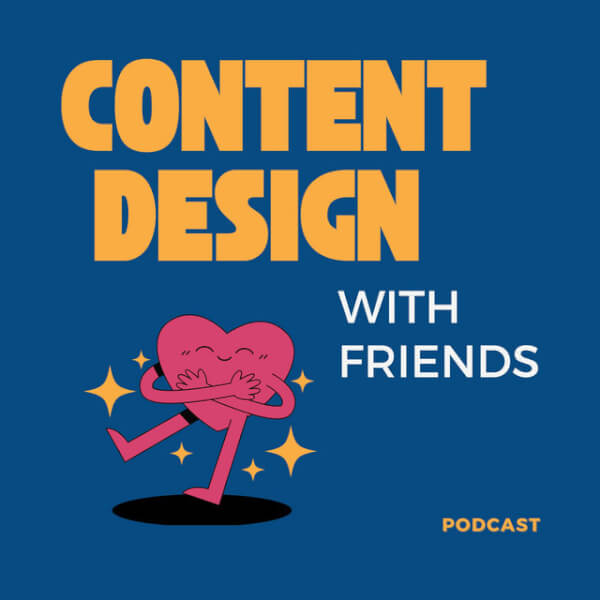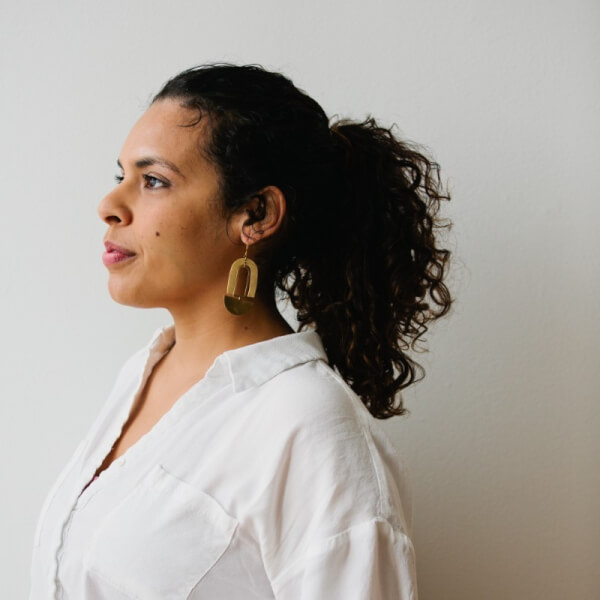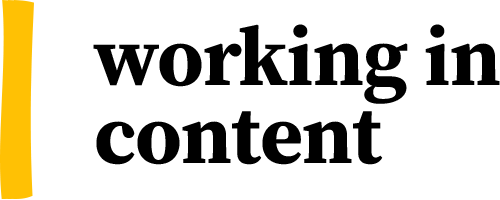Recently, we had the opportunity to host an Office Hours event with the team behind the Content Design with Friends podcast. This group of experienced professionals, hailing from diverse industries like music streaming, travel, search, social media, online shopping and fintech, joined us for a conversation that was both insightful and engaging.
The session was filled with valuable insights, experiences, and practical advice, with our guests addressing a wide range of questions from our community. They covered topics such as understanding job roles, enhancing career development, mastering content strategy, managing teams, navigating recruitment processes, envisioning the future of content design, and maintaining work-life balance.
Our guests Susanna Agababyan, Laura Costantino, Laura Lopez, Rosie Olaivar, and Camila Pechous shared their experiences and perspectives, offering practical advice and stimulating thoughtful discussions. The event was not just about learning from these experts, but also about sparking conversations and encouraging participants to think more deeply about their work and the field of content design.

To help you navigate the wealth of information shared during the event, we've organized your questions into categories. Each category represents a unique aspect of content design, and we invite you to explore them all. So, without further ado, let's dive in!
On this page:
Understanding job roles and responsibilities
If you're just starting to navigate the world of content design, you might be wondering about the specifics of various roles and responsibilities. What does it mean to be a "senior" content designer or UX writer? How can a team transition from a reactive to a proactive role within a company? This section delves into these questions, providing insights from experienced professionals in the field. Read on to gain a clearer understanding of these roles and what they entail.
Question #1 from the audience
What does a "senior" Content Designer or UX Writer mean to you?

In my perspective, a senior is someone who operates on multiple levels. They can handle specific tasks for specific teams, as well as lead complex projects that require a lot of scoping and defining. Additionally, a senior's role extends beyond their own work - they help enhance the skills of their peers, assisting them in tackling challenging tasks.

The definition of 'senior' can vary from company to company, but here's my take:
A senior is someone who can work strategically, not just delivering the content but also involved in scoping, planning, and cross-functional collaboration with stakeholders.
A junior UX Writer or Content Designer might struggle in an unexplored area (like a new feature or product), whereas a senior can confidently conduct explorations, perform research, and gather the necessary inputs to do the work. In essence, a junior might need pre-existing inputs to deliver content, while a senior can handle both strategy and delivery.
In short:
At the junior or craft level, the focus is tactical. At the senior level and above, the focus is strategic (and they're also capable of handling the tactical aspects).
Question #2 from the audience
What would you say are the first few steps a UXW team can take to transition from reactive work to a more proactive role in the company?

Identify a sponsor at the leadership level—someone who can champion and elevate your team. Change often encounters resistance, so it's crucial to find an advocate for your team.
You don't need to secure everyone's support right away. Start by identifying one person and build from there.

Engage your leaders and encourage them to create space for your success.
Another suggestion is to reflect on what's causing your reactivity. Is it a specific individual? Perhaps it's time for a one-on-one conversation with that person to reset expectations around your work style and future collaborations.
If the issue is that the discipline is new and people don't understand how to work with UX writers, consider conducting a roadshow - a series of presentations explaining what UX writing is, why it's important, the value it brings to the business, and the best ways to collaborate with your team. This can help others understand their misconceptions and what needs to change.
Initially, this may be a bit frustrating, but often people simply don't understand our work process and make assumptions about when to involve us. Being clear, setting expectations, and educating them can be a significant step towards overcoming this.
Another strategy could be resetting expectations with the entire team. Let people know what the acceptance criteria will be for any UX writing-related work during the planning stage.
If you're working on a project, communicate what you expect to receive. If someone introduces something new, but you already have multiple tasks on your plate, they need to discuss with other product people or stakeholders to reprioritize so that you can take on more work.
This might be a little frustrating for people as they're probably used to you always saying "yes" to everything. But you need to start saying "no", you need to communicate the standards you expect for any work that we receive. If those standards aren't met, we're going to say "no". If we have too much on our plate, we're going to say "no" because we are human.
And then you can always give them a little something back, right? Especially when that relationship is just starting out and you're beginning to say "no". One of the things that I did that was really successful for our design team was implementing office hours. These were dedicated to handling any ad hoc requests from any stakeholder at any part of the business.
They had one hour and they had to come in and meet certain criteria. We were not going to work on anything where if someone else was part of that work but wasn't present and couldn't explain it, we were not taking that work in. So they had to be able to fully explain it. They had to have already discussed any considerations that we needed to have for the work.
Then they could reasonably expect, if they met our criteria, that they would have the work done for them by the end of the hour. And if we wanted to, we might spend time on it over the next 24 to 48 hours if we didn't finish it. But it was never a promise that we would continue if we ran out of time.
This approach was really successful. We went from having about 20+ requests a month for ad hoc work to literally just two. It was a dramatic shift just by offering that and then saying "no", outside of those office hours. We did it once a week, and we chose Wednesdays so that people had Monday and Tuesday to think about things, and they could bring it on Wednesday.
If something came up on Thursday, well, they had to wait until Wednesday the following week. Too bad. So, getting those "nos" out can be really helpful for people to start respecting your time, your energy, and your process. Good luck.
Career development and skills enhancement
As you progress in your content design career, you might be thinking about how to enhance your skills and move up the ladder. What's the best way to train junior UX writers? How do you know if a managerial path is the right one for you? This section offers valuable insights and practical advice from seasoned professionals on how to develop your skills and prepare for more senior roles.
Question #3 from the audience
What is the best way to train junior UX Writers?

In my experience, the approach to training junior UX writers varies from individual to individual. The first step is to understand what the junior UX writer is already proficient at and where they need more guidance. This process involves careful observation and thoughtful discussions during one-on-one meetings.
Question #4 from the audience
How do you know if a manager path is the right one for you?

This is a great question, and it's something I'm currently contemplating myself! A piece of advice I received from a former leader was, "When you find more joy in helping others achieve their goals and witnessing their growth, it might be a sign that a leadership role could be a good fit for you."
I've observed this tendency in myself, so I've started participating in an Aspiring Leaders course that my company provides for those considering leadership roles. If your workplace offers a similar program, I'd recommend taking advantage of it. At the very least, you'll acquire valuable skills for leading as an individual contributor at a Senior, Staff/Lead, or Principal level.
If your workplace doesn't offer such a program, I'd suggest exploring Michael Mett's course, Leading Like You, or subscribing to his newsletter.
Question #5 from the audience
How do you keep your Content Design skills fresh? How do you stay up-to-date with industry? Where are you getting info from?

For me, inspiration and learning opportunities are everywhere!
I work in fintech, so I often gain insights into what others are doing just by using digital payments in my daily life and checking my bank account.
I'm a big fan of the books from A Book Apart. They're concise and informative, allowing me to quickly absorb a wealth of knowledge.
While I used to attend workshops and talks, these days I'm focusing more on learning about AI.
LinkedIn is a fantastic resource for staying up-to-date. I often pause to read posts about the work people are doing or articles they've found valuable.
At work, we have a chat for designers where people share their projects, lessons learned, and other interesting tidbits. It's a great way to learn about things I might not encounter outside of work.

For me, there are two key aspects:
Enhancing your CD skills. If you're a practicing CD/UXW, you're already keeping your skills fresh. The question is, are there any gaps you might discover that you feel the need to fill?
Staying current with the industry. This is a broad area. There are certain things that we, as CDs, need to consistently check and keep in mind. For example, what are the latest developments in accessibility practices? Are there new methods I can incorporate into my work today to improve the digital world? There are also many ongoing conversations about content design. However, it can be overwhelming to try to keep track of everything. It's okay to choose the discussions that resonate with you. Maybe you're particularly interested in how other companies are using AI. This curiosity can fuel your work and help you perform better and faster, freeing up more time for complex tasks.
But remember, you don't have to stay on top of absolutely everything to be a good UXW/CD. There's so much out there.
Question #6 from the audience
Can you share any practical tips or advice for up-skilling yourself to demonstrate that you’re worthy of taking on more senior content roles in your org?

The approach can vary depending on your organization's culture and your relationship with leadership.
A good first step is to discuss with your leader the possibility of taking on new projects or tasks. It's helpful if you can identify the work you're interested in and articulate its potential impact on the business or your career. Also, assure them that you can manage this additional work while still fulfilling your regular duties.
In my case, my leader was clear that as long as I was still delivering on my work, it was fine to take on extra work. Also, in my company, promotions aren't based on someone's potential to succeed at a higher level, but rather an acknowledgment that you are already performing at that level and have been for some time. So, we're encouraged to identify higher-level work and share the impact we're making by doing that work. You can also include this work in reviews, but remember to share with everyone the work you're doing, so you are seen as being capable of taking on that kind of work in the future.
Essentially, the best way is to start doing the work and ask those at a higher level for their feedback. You can even ask someone to mentor you through it.

As Rosie mentioned, the approach can depend on the company you work for. Many organizations have career ladders that can help you and your manager identify the gaps you need to fill to advance.
Question #7 from the audience
What's more important to you: experience or training / certifications?

For me, experience takes precedence. I've encountered many talented writers who have never taken a design or UXW/CD course. The ability to learn and apply your experiences to UXW/CD is invaluable. While anyone can take a course, not everyone can apply the knowledge effectively. So, when I see a certification, I approach it with a degree of skepticism until I see a portfolio. Even if you haven't had the job (considering people who change industries), you can still create a portfolio. As long as you can demonstrate your thought process and how you would apply what you've learned, you're on the right track!
Question #8 from the audience
What makes a Content Designer candidate stand out in the interview process?
Could your answer speak to the importance of qualifications over years exp., and the need for portfolios and writing “outside” of the job (i.e. personal blogs, websites, medium etc), and anything else you look for?

In my opinion, beyond CVs and portfolios, the candidate's way of thinking is crucial in UX. If a candidate can articulate their thought process and explain their reasoning, not just present solutions, it speaks volumes. I've encountered candidates from diverse backgrounds, but what matters is how they leverage their skills and knowledge and apply it to UX. A piece of advice I once received from a fellow UX writer was to remember that as a UX writer, you are a creator. So, craft your narrative intelligently.
The definition and scope of the role can vary greatly, not only between companies but also between teams within the same company. In the face of such uncertainty, the best thing you can do is showcase your process, flexibility, and ability to reflect on situations, draw the right conclusions, and propose solutions accordingly.

Here's a somewhat controversial opinion: while activities outside of work can be beneficial, they aren't the deciding factor in an interview if a candidate lacks the basic skills required for the job.
No matter how much of a UXW/CD superstar someone might be, if they can't perform the actual job, it's a no-go. So, while I think these activities are nice to have, they aren't what make a candidate stand out.
What I value more in an interview setting is how a candidate interacts with cross-functional stakeholders, their mastery of the craft, and so on.
Question #9 from the audience
As a Thai UX Writer experienced in "translating" rather than "localizing" Thai to English for a bilingual digital product, what skills should I develop to qualify for a role as an English UX Writer in a global company where multiple languages are localized?

Honestly, there aren't any specific skills required. If you're already a UX Writer, being multilingual is a significant advantage, as is having a background in translations. The role of a UX Writer isn't limited to those whose first language is English. In fact, we have an episode on our podcast titled Working in content when English isn’t your first language that you might find useful.
What you really need is to find companies that value what you have to offer. Fortunately, there are more and more such companies these days.

I wholeheartedly agree with what Susanna said.
You already possess the necessary skills. Your problem-solving approach and curiosity won't change whether you're writing in Thai or English. While you can certainly emphasize your writing skills and explain why you chose certain English terms, focus your energy on design thinking, not grammar. UX writing is about more than just writing.
Question #10 from the audience
How to get interview calls for UX Design jobs for recent grads?

When I apply for jobs, I prioritize quality over quantity. I typically seek roles where I believe I have a good chance of success, such as industries I'm familiar with or where I might have a connection who can provide a referral. Unfortunately, there's no secret formula, but I can confidently say that my network has been instrumental on numerous occasions. However, building a network isn't an overnight task and it's not a magic solution: it requires time and effort to nurture a network, but when you need it, it's there to support you.
Question #11 from the audience
How in-depth is software knowledge accessed during the interviews?

The depth of software knowledge required can vary significantly based on the job and even the specific company. You can usually get a sense of the necessary software skills by reviewing the job description. If a particular software is mentioned there, it's likely important. For some UX designer roles, you may be asked to perform interview exercises using a specific software (likely Figma). So, if you're not proficient in that software, it would be a good idea to familiarize yourself with it.
Question #12 from the audience
How you hone your "voice and tone" skill for crafting UX copy?

A creative writing exercise that I find enjoyable (though it might be more appealing to writers) can help you develop this skill, even if it's not specifically for UX copy.
Choose a piece of text: a few lines from a movie, a common saying, an excerpt from a book you like, then invert it. How would you rewrite that text from the perspective of a completely different character? What would their voice sound like? How would their tone change in different scenarios?
Take that saying, then try different personas (Barbie! Elmo! Danny Trujillo! Dominic Toretto from the Fast and Furious movies!) and see how the voice and tone adapt. How would Barbie inform someone that their changes couldn't be saved? What about Elmo? What if it's a page that couldn't load? How would each of these characters deliver that message differently?
While these are extreme examples, this is the essence of applying voice and tone. What's the company's voice: what does it sound like? And how does it flex depending on the scenario? It might seem a bit geeky, but the more you get into the habit of thinking: "ok, what's the situation here and how do I need to deliver a message about it?" the better you can do that in a UX writing/content design scenario.

I wholeheartedly agree with Laura's points. Additionally, I'd like to emphasize that there's a clear distinction between voice and tone. Voice is static and integral to brand identity, meaning it doesn't change with context. As Laura mentioned, tone does change with context and moves along a spectrum. For instance, a celebratory tone may work in some instances for your brand but not others.

One way to better understand voice is to use AI to mimic someone's voice. This can help you notice how the same message can change depending on the voice used.

Establishing voice and tone guidelines is a crucial first step, and it's usually a collaborative process. If those guidelines don't exist at your company, you may not have a benchmark to validate against.
Content strategy and tools
As a content designer, you're likely to encounter a variety of tools and strategies in your work. You might be wondering about the benefits and challenges of different tools, such as Figma and copy docs, or how to tackle large tasks like building out a content style guide or an enterprise taxonomy. This section explores these topics, providing insights from professionals who've navigated these complexities. Read on to learn how to make informed decisions that best suit your needs and the needs of your team.
Question #13 from the audience
As a freelance UX Writer accustomed to working directly in Figma, how can I effectively transition to using a copy doc for UX writing, as requested by a designer in a larger company? What are the benefits of using a copy doc over working directly in Figma, especially in the context of larger content teams?

My personal preference leans towards using spreadsheets to document my copy choices, though I might be the only one on my team who does so.
There's a lot to consider here. Some designers can be protective of their work and prefer not to share their Figma file, which is not acceptable. However, there could be a case made for version control and tracking rationale that favors having a source of truth document, which may or may not be in Figma.

To be honest, I use both. It depends on the project, but I maintain a document for every project I'm working on, where I lay out my iterations, work in progress. I also work in Figma, especially for the reasons you mentioned. For example, I write for both the app and the web, so I need to check how my copy will look in the end. Will it fit?
As Laura mentioned above, I also use spreadsheets for the final copy as a source of truth for everyone to refer to when they need to quickly check the latest version.
That being said, everyone has their own ways of working. You need to find what works best for you and stick to it. People can comment in Figma too (we do that, we use both Figma and docs for feedback, for instance). But as the writer, you have the final say in what you prefer using and how exactly.

I maintain a certain structure in my documents. I gather all the necessary information at the top to make it easily accessible at all times. Then it varies. Sometimes I have sections dedicated to iterations (MVP, iteration after the initial launch). Sometimes specific components that need to be worked on. I copy this structure from document to document, but keep it flexible. The same goes for spreadsheets.

Here's my approach:
I actively work on content in Figma alongside my designer. If the designer is sensitive about me altering their design files, I create a "UXW playground" page where I can house my working content.
I work closely with my designers, so when there's a major update with design, I can pull in the new designs and transfer my content to them, tweaking it if the designs impact the content, and so on.
I also conduct content reviews in Figma, so folks can leave comments there.
When it's time to ship content "specs": all my final content is captured in the design specs. Then I create a content document with screenshots and links to the exact screen in Figma, along with localization notes, interaction notes, and each element (every headline, subheader, helper text, etc.). This is more for engineers so they can easily copy/paste the strings. Many engineers I've worked with don't know how to use Figma and if they don't know how to copy/paste from Figma, they type out the content and that's how we get capitalization and spelling errors.
Also, if the designer doesn't provide more information about WHY they need a copy doc, I'd interpret their silence as "just kidding, I don't need a copy doc after all."
Question #14 from the audience
I’m one content strategist on a scrum team. I’m tasked with building out our content style guide & now asked to create an enterprise taxonomy/glossary/terms guide. Looking for all the tips and advice on tackling this elephant.

That's quite a task! It's not impossible, but it will require a significant amount of time, clear priorities, and a well-structured roadmap. On a side note, I'm a big fan of the scrum/agile methodology. I wish I could work in that manner more often.
Remember, your MVP doesn't have to be perfect. Start small and build from there.

You could begin by examining the terminology list to identify inconsistencies, what's working, and what needs to be updated. This approach will allow you to provide realistic deadlines to leadership. If your company is large and other writers or team members use that terminology list, it would be beneficial to involve them in the process.
Don't forget to define what success looks like for you. Are you aiming to drive adoption or deliver something by a specific date? You'll want to demonstrate later how this substantial initiative benefited your team or organization.
You're going to do great! Remember, done is better than perfect.
Question #15 from the audience
Our UX Writer recently left and my company has no plans to replace them. I’m currently on the content marketing team, but am shifting my career focus to content design. Do you have any tips for how I could get involved with CD projects without stepping on any toes (my manager’s and potentially our product team)?
One of our product designers said they “can just use chatgpt to write copy” instead of filling the role… so that’s what we’re workin’ with.

First, addressing the AI question: while they can certainly attempt to use AI for writing copy, they should be aware that any information shared with the model automatically becomes public, which is a significant risk.
As for your career shift, I recommend having an open conversation with your manager. Do you usually discuss career development?

That's a challenging situation. Given what you've shared, it seems like you might be answering your own question. This company may not be the right place for you to make the switch, but that doesn't mean you can't transition to a different role in the future.
You could try to get involved casually, but I would first suggest establishing a relationship with a UX designer or Product Manager. This might mean taking on extra work, but you could frame it as an effort to ensure that the company maintains a consistent brand voice in both marketing and in-product copy.
If you encounter resistance, you might need to start considering roles outside of your current company, especially to avoid souring relationships that already seem complex based on what you've told me.

I'm sorry to hear that you're in a workplace where you don't feel psychologically safe, especially in your relationship with your manager.
I agree with Laura's suggestion that this might not be the best place for you to make the transition.
What you can control is documenting your current projects that go beyond your current role, especially those that are UX writing or content design focused. This will provide material for your portfolio once you decide to leave. As I mentioned in another thread, I value experience over training in an interview setting, so being able to demonstrate that you can handle UX writing tasks is crucial!
Team management and collaboration
Managing a team and fostering effective collaboration are key to the success of any content design project. But how do you manage stakeholder expectations or enforce content guidelines across different departments? This section delves into these questions, offering practical tips and advice from experienced professionals on how to foster a collaborative and efficient team environment.
Question #16 from the audience
What does a new and small UX Writing team need to make sure it is efficient when more UX Writers join? For example, going from a team of 2 to a team of 6. What should be ready before the other writers arrive?

A crucial aspect to consider when expanding a UX Writing team is to have clear project ownership. The last thing you want is for new members to step on each other's toes or, worse, create duplicate work.
If you're growing your team, it's essential to understand what the new UX Writers will be responsible for. This way, they can also build relationships with their stakeholders and demonstrate their impact, rather than having all the work fall into one giant bucket that the team has to scramble over.
When the new UX Writers join, it's also important to have a proper onboarding process. Who are the key people they should know in their sphere? What tools do they need to be successful? If you're unsure, talk to the current UX Writers for insights. They may be facing issues now (like a lack of tools, stakeholder issues, etc.), and if these aren't addressed now, they could escalate once you add more team members.
Question #17 from the audience
Laura, you recently said that "The day we decided to draw a line between content strategy, tech writing, and UX writing we made a huge disservice to people, audiences, customers." If you could snap your fingers and create your dream org structure for all things content at a company, what might that look like?

Large organizations, like the one I currently work for, can be quite challenging to manage. However, in an ideal world, I would advocate for keeping content separate, with its own dedicated leadership structure. Often, the problem arises from the top, where there is a lack of content leaders at the highest levels of decision-making.
Question #18 from the audience
Do you have any tips for: Stakeholder management for a UX Writer handling multiple work streams at once? Documenting projects within a growing team and/or for your personal portfolio?

Sarah Doody has a fantastic "Project Diary" template that I've been utilizing for years. It's a document that you use to record projects as you work on them. It's a real time-saver!

My team maintains a document that clearly outlines what we do in each phase of the design process (this document is separate from the design... because they don't have one!) and we share this document openly with our stakeholders.
I also create a working document based on the phases to transparently show how much time I anticipate each task will take for each project I undertake. For example, part of the work I'm doing involves conducting an audit. I can't complete those in one business day. So, I try to demonstrate, based on a PRD or design brief, the requirements I think you all have, where I think we need this content audit, and areas where I think content can contribute. Lay that out in a Gantt chart or even just a schedule for yourself and share it. Ensure that product, engineering, and design are all aware of your deadlines/deliverables so everyone's aligned.
If you receive additional requirements that require time, you can say, "Hey, I have XYZ things due this week, and you say you need this deliverable ASAP. Since we didn't plan for it, which of these pre-planned deliverables can ship next week as opposed to this week?" Obviously, if you have the time to handle last-minute requests, it's always good to be flexible. But if a stakeholder is constantly asking for changes and not allowing for the time to make them, document those so if you can't meet a deadline, you can clearly show why.
Question #19 from the audience
What are processes you would recommend to collectively enforce content guidelines across writers in different departments, or across an org in general?
I currently work for an org that doesn't have a high UX maturity, I am the solo product writer. Lots of folks across the org (marketing, etc) seem to have tried to write guidelines over the years, but they haven't stuck. Writing guidelines is one thing, finding ways to get everyone to stick to them is a whole other beast.

There's an American saying: "You can lead a horse to water, but you can't make it drink."
This means you can guide everyone to something, but you can't force people to do the thing you want them to do.
My question back to you is: what have you done to socialize the content standards? Have you had conversations with folks in small groups about the content standards? How have you promoted them? If your cross-functional stakeholders can't see the value of it, they won't use it. Perhaps there's more you need to do in terms of gaining people's buy-in or helping them understand the value of it and how it can assist them in their daily work.
Adoption is incredibly challenging, and the way I've addressed this is by bringing cross-functional folks into the fold so they have buy-in.
Question #20 from the audience
What UX Writing team rituals can help with improving the team’s hard and soft skills?

I believe Craft and Learning sessions can be incredibly beneficial. That's what we currently have in our UX Writing team, and it's proven to be very helpful. Craft sessions occur on a weekly basis, while Learning sessions take place once every three weeks. We all shared what we wanted to learn first to define the topics – whether to learn something new or boost existing skills. We also determined whether we could just come together and practice on our own (especially if one member of the team already possesses that skill and can teach peers) or if we needed external speakers.
Craft sessions are a great way to regularly come together and discuss pressing matters – the projects that everyone's working on, successes, challenges. It's also a valuable space to give feedback to each other. Because that really, really helps everyone grow.
Job interview and recruitment process
The job interview and recruitment process can be a daunting experience, but it's an essential step in landing a role in content design. This section provides insights into the recruitment process, offering advice on how to make it more inclusive and discussing the differences in working in content in Europe versus the US. Whether you're new to the field or an experienced professional, these insights can help you navigate the recruitment process with confidence.
Question #21 from the audience
If you had the power and the will, what would you change about the standard recruitment process to make it more inclusive? I ask this as someone who is totally rubbish at interviews, but would consider myself an ok Content/UX Writer.

I'm intrigued to know what makes you feel you're "rubbish at interviews" – your words, not mine! ;)
One approach could be to let your work speak for itself through your portfolio, and perhaps request the opportunity to submit a writing exercise. However, it might also be worth delving deeper into why verbal communication might be challenging for you.
Presentation is an acquired skill, one that can be honed with practice. It's also a skill often required for all UX practitioners. There might be ways to navigate around this, but it's something to consider.

Here are a few things I'd change:
I'd train recruiters to understand what we're looking for. Too often, they don't really grasp UX Writing/Content Design and end up forwarding candidates who aren't a good fit for the role. However, when I sift through the 100+ resumes we sometimes receive for an opening, I find a multitude of amazing people!
I'd eliminate tests for roles that are mid-level and above. I don't believe they contribute to the process and instead place an undue burden on candidates. If a candidate doesn't have a portfolio because most of their work is covered by NDAs, then perhaps a short test might make sense. But even then, it should be an assignment that is unrelated to the business, asks for a small thing, already includes the wireframes to work off of, and is evaluated more on their thought process than the quality of the content.
I'd advocate for salary transparency!! Recruiters should never ask what people make, or are looking to make. Neither should applications. The salary range should be clear, and it should be even clearer what the range is for the location the candidate is applying from if that is taken into account. Recruiters should also share what is usually standard in offers, like maybe the company usually targets the middle of the range and only offers the max for exceptional candidates who are practically at a higher level.
I'd provide a clear update on what to expect before moving on to the next stage. If a case study is expected, people should know from the beginning so they can better prepare themselves.
Question #22 from the audience
What differences have you observed for working in content in Europe vs US?

Although I'm originally from Italy, I moved to the US right after college and don't have professional experience in Europe, so I can't answer from personal experience. I believe a lot depends on the size of the company rather than just the location. I've worked in very large companies where hiring processes are very standardized. In terms of job searching, I'd say networking is effective almost everywhere. It's certainly important in Italy, and the same holds true in the US.
Susanna, do you have any additional insights about Europe?

When it comes to job searching and interviewing, I completely agree with Laura. Especially in our industry, networking can take you a long way. However, the processes are more or less standardized in larger companies, with maybe one step more or less, but overall, they're similar.
In terms of daily work, I wouldn't compare the US vs Europe in general, because it really varies drastically from country to country within Europe. For instance, I currently live and work in the Netherlands, and I conducted thorough research before moving here. The topic that interested me the most was work-life balance, which the Netherlands is famous for. But if you go to Italy (Laura, correct me if I'm wrong, I'm speaking from my past experiences), this work-life balance is barely existent. So, it really depends on the country.
Future of content design
As technology evolves, so does the field of content design. You might be curious about the potential incorporation of AI in design processes or have questions about where content design might be in the next few years. This section looks into the future, offering insights from professionals who are at the forefront of the field. Read on to get a glimpse into the potential future of content design.
Question #23 from the audience
Should the content community look to incorporate AI in design processes? (assuming it'll be around for a while as "innovative technology")

In my opinion, yes, we should. However, it's crucial to set the right boundaries and not rely on AI for decisions that require extensive thought and elaboration.
I believe that AI can help us handle smaller tasks more efficiently, allowing us to dedicate more time to strategic work.

I'm completely in favor of it! Any tool that helps us complete our tactical work faster, so we can focus on all the other things we need to do, is a welcome addition to our workflow. Of course, AI still has some issues to resolve around securing company IP, but I believe we'll get there eventually.

I agree! To a certain extent, I think AI can assist with tactical work that perhaps doesn't need your full attention. However, we need to be cautious as we can't feed it information that may be classified.

I can't imagine my work without Grammarly. So, my answer is yes, let's bring AI to help us with tactical work.
Question #24 from the audience
When you think about where Content Design might be as a career or a community of practice in, say, 3 to 5 years… what's something you're feeling optimistic about right now? And what's something you're feeling pessimistic (or anxious) about?

I'm both excited and concerned about AI.
In my ideal vision of the future, writers collaborate closely with assistive AI technology to shape the strategy behind the product and the experience.
On the flip side, my worst-case scenario involves writers, makers, and creators being sidelined. Not by the technology itself, but by those who misuse it for personal gain, in their pursuit of power and wealth.

There's so much about AI that remains unknown. I feel like there will be a shift, with content design becoming more about project managing content rather than crafting experiences.
What I'm observing now, and hope changes soon, is companies hiring Content Designers on a contract basis because they're not ready to fully commit to content design or invest in it just yet.
Will we see a surge in freelance content designers hopping between gigs? These are just my random thoughts, and I don't have any definitive answers yet.
Work-life balance and motivation
In the fast-paced world of content design, maintaining a healthy work-life balance and staying motivated can be a challenge. But how do you recharge your proverbial batteries? What keeps professionals energized and motivated about UX writing and content design? This section focuses on these questions, offering insights from professionals who've found ways to balance their work and personal life while staying passionate about their careers.
Question #25 from the audience
How are you recharging your proverbial batteries? What keeps you energized/motivated about UX Writing and Content Design?

I've recently received a couple of valuable pieces of advice:
Let the work speak for itself, meaning, remove yourself from discussions that aren't productive.
Give the people who don't appreciate your work only crumbs. Save your energy and creativity to bake the cake for the work that truly matters to you.

Laura, that's such great advice. I'd add that I've recently started evaluating my projects. I ask myself: What is a passion project? What is a necessity? What requires a lot of effort from me, but will help me grow? Then, I treat the projects accordingly. It's also a red flag if none of the projects are passion projects because those are the ones that provide so much inspiration to keep doing what I'm doing.
And yes, recharging in time and removing yourself from unnecessary discussions is crucial. I'm learning this last one now. It's a game changer.

I've recently learned that I can't and never will control other people's perceptions about content design, my work, etc.
Now, I focus my energy on sharing what I know (instead of "proving my value") and engaging in productive discussions.
After work, I recharge my mind by refinishing old furniture, knitting, and creating toys for my kids.
Final thoughts and takeaways
And there we have it! We've journeyed through an insightful Q&A session with the knowledgeable hosts of the Content Design with Friends podcast. We've touched on a wide range of topics, from understanding job roles and responsibilities, to enhancing career development and skills, exploring content strategy and tools, managing teams and fostering collaboration, navigating job interviews and recruitment, contemplating the future of content design, and maintaining work-life balance and motivation.
Our experienced professionals have generously shared their experiences and practical advice. They've highlighted the importance of continuous learning, adaptability, and teamwork in the dynamic field of content design. They've also given us a glimpse into the future, discussing the potential role of AI in design processes and the need for more inclusive recruitment practices.
Their collective wisdom is a treasure trove for anyone in the content design field, whether you're just starting out or a seasoned pro. As we navigate the ever-evolving landscape of content design, these insights serve as our compass, guiding us towards growth, innovation, and success.
So, let's take these nuggets of wisdom, roll up our sleeves, and continue to shape the exciting world of Content Design!







